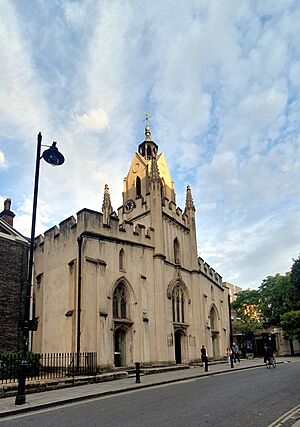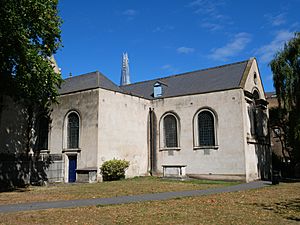St Mary Magdalen Bermondsey facts for kids
Quick facts for kids St Mary Magdalen, Bermondsey |
|
|---|---|

St Mary Magdalen, Bermondsey
|
|
| Lua error in Module:Location_map at line 420: attempt to index field 'wikibase' (a nil value). | |
| OS grid reference | TQ333795 |
| Location | Bermondsey in the London Borough of Southwark |
| Country | England |
| Denomination | Church of England |
| Website | http://www.stmarysbermondsey.org.uk/ |
St Mary Magdalen Bermondsey is an old and important church in London. It's a Church of England church, meaning it's part of the main Christian church in England. This church is dedicated to St Mary Magdalen. Most of the building you see today was built a long time ago, in the late 1600s. It's so special that it's a 'Grade II* listed' building. This means it's protected because of its history and beauty.
The area this church serves, called its parish, is quite large. It reaches all the way to the River Thames. This includes famous spots like the south tower of Tower Bridge and part of London Bridge station. Other nearby church areas, or parishes, have joined with St Mary Magdalen's over time.
Contents
A Look at the Church's History
The first time a church was recorded on this spot was in 1290. It served the workers at Bermondsey Abbey, which was a large monastery. We don't know exactly what that first church looked like.
Building the Church We See Today
In 1680, the old church was taken down. A new one was built in its place. They kept the old tower from the 1400s, which had a cool Gothic window and arches. The new church was finished around 1690.
Later, more parts were added. A north gallery was built in 1705. A south gallery was added in 1794. The south gallery still has its original boxed pews. These are like small private rooms for families to sit in during church services.
Changes Over the Years
More changes happened in 1830, led by an architect named George Porter. He updated the tower and the front of the church. He also brought back the old medieval window. Some parts that stuck out into Bermondsey Street, like a porch and a school, were removed.
In 1852, the inside of the church was redecorated. It was given a Gothic Revival style, which means it looked like older Gothic churches. In 1883, the chancel (the part of the church near the altar) was made longer. A new stained glass window was put in, along with other improvements.
The church survived the Blitz, which was a time of heavy bombing in London during World War II. However, the inside of the west end was damaged by fire in 1971. The outside of the church was covered in a special coating in 1829 and again in 1994. Today, St Mary Magdalen is the oldest building in its area. You can still see the medieval arches inside the tower, behind the organ.
The Church Organ
The church had an organ installed in 1751. This organ was replaced in 1851 by a company called J.W. Walker. The older organ was then moved to another church in Wiltshire.
Special Treasures of the Church
Inside the church, you can see two beautiful carved stone pieces. These are called capitals and are very old, from the medieval period. They were found nearby in the early 1900s. They are almost certainly parts of the original Bermondsey Abbey.
The church also owns a very special silver item called the Bermondsey Mazer. A mazer is a type of drinking cup. This mazer is kept safe at the Victoria and Albert Museum. It is believed to be the only silver item left from Bermondsey Abbey.
The church is also connected to the Worshipful Company of Parish Clerks and the Bermondsey Tanners Company. These are old groups, or guilds, that have historical ties to the church.
The Churchyard and Burials
The churchyard, which is the area around the church, was used for burials for many years. However, in 1854, it was closed for burials. This was common for London churchyards because they became too crowded and could cause health problems.
The churchyard has several old monuments and tombs. One notable tomb belongs to the ancestors of Charles Rolls. He was a pioneer in aviation and helped start the famous company Rolls-Royce. Today, the churchyard is looked after by the local council. The old church records are kept at the London Metropolitan Archives.
In 1553, a list was made of all the church's ornaments and special clothes. This list included "a painted cloth to hang before the Rood in Lent." Records also show items that were sold during the English Reformation, like an "old cope of red silk with roses of silver and gilt." The church also had Bible verses painted on its walls and a new timber porch.


